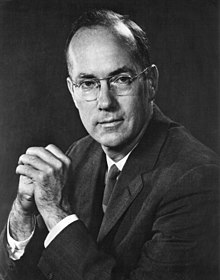Charles H. Townes | |
|---|---|
 Townes in 1983 | |
| Born | Charles Hard Townes July 28, 1915 |
| Died | January 27, 2015 (aged 99) Oakland, California, U.S. |
| Alma mater | |
| Known for | |
| Spouse |
Frances Brown (m. 1941) |
| Awards |
|
| Scientific career | |
| Fields | Physics |
| Institutions | |
| Thesis | Concentration of the heavy isotope of carbon and measurement of its nuclear spin (1939) |
| Doctoral advisor | William Smythe |
| Doctoral students | |
Charles Hard Townes (July 28, 1915 – January 27, 2015) was an American physicist.[4][5] Townes worked on the theory and application of the maser, for which he obtained the fundamental patent, and other work in quantum electronics associated with both maser and laser devices.[6][7][8][9][10][11][12][13][14] He shared the 1964 Nobel Prize in Physics with Nikolay Basov and Alexander Prokhorov.[3][15][16] Townes was an adviser to the United States Government, meeting every US president from Harry S. Truman (1945) to Bill Clinton (1999).
He directed the US government's Science and Technology Advisory Committee for the Apollo lunar landing program. After becoming a professor of the University of California, Berkeley in 1967, he began an astrophysical program that produced several important discoveries, for example, the black hole at the center of the Milky Way galaxy.
Townes was religious[17] and believed that science and religion are converging to provide a greater understanding of the nature and purpose of the universe.
- ^ Charles Hard Townes Archived August 8, 2020, at the Wayback Machine retrieved 29 July 2020 in Wilhelmexner.org
- ^ Cite error: The named reference
formemrswas invoked but never defined (see the help page). - ^ a b Boyd, Robert (2015). "Dr. Charles H. Townes (1915–2015) Laser co-inventor, astrophysicist and US presidential adviser". Nature. 519 (7543): 292. Bibcode:2015Natur.519..292B. doi:10.1038/519292a. PMID 25788091.
- ^ "Charles H. Townes – Biographical". Nobelprize.org. 2006. Archived from the original on July 28, 2014. Retrieved July 29, 2014.
- ^ Staff. "About Charles Townes – Charles H. Townes Lecture Series". www.furman.edu. Furman University. Archived from the original on July 27, 2020. Retrieved May 1, 2020.
- ^ Bertolotti, Mario (2004). The History of the Laser. Taylor & Francis. ISBN 978-0-7503-0911-0.
- ^ Bromberg, Joan (1991). The Laser in America, 1950–1970. MIT Press. ISBN 978-0-585-36732-3.
- ^ Chiao, Raymond, ed. (1996). Amazing Light: A Volume Dedicated To Charles Hard Townes On His 80th Birthday. Springer. ISBN 978-0-387-94658-0.
- ^ Chiao, Raymond, ed. (2005). Visions of Discovery: New Light on Physics, Cosmology, and Consciousness, A Volume Dedicated to Charles Hard Townes on his 90th Birthday. Cambridge. ISBN 978-0-521-88239-2.
- ^ Haynie, Rachel (2014). First, You Explore: The Story of Young Charles Townes (Young Palmetto Books). University of South Carolina Press. ISBN 978-1-61117-343-7.
- ^ Hecht, Jeff (2005). Beam: The Race to Make the Laser. Oxford University Press. ISBN 978-0-19-514210-5.
- ^ Hecht, Jeff (1991). Laser Pioneers. Academic Press. ISBN 978-0-12-336030-4.
- ^ Taylor, Nick (2000). Laser: The Inventor, the Nobel Laureate, and the Thirty-Year Patent War. Simon & Schuster. ISBN 978-0-684-83515-0.
- ^ Townes, Frances (2007). Misadventures of a Scientist's Wife. Regent Press. ISBN 978-1-58790-128-7.
- ^ "Nobel laureate and laser inventor, Charles Hard Townes, dies at 99". Berkeley.edu. January 27, 2015. Archived from the original on January 28, 2015. Retrieved January 27, 2015.
- ^ Charles H. Townes's publications indexed by the Scopus bibliographic database. (subscription required)
- ^ Riess, Suzanne B. (1992). "A Life in Physics: Bell Telephone Laboratories and World War II; Columbia University and the Laser; MIT and Government Service; California and Research in Astrophysics". California Digital Library. Archived from the original on February 8, 2023. Retrieved September 4, 2016.